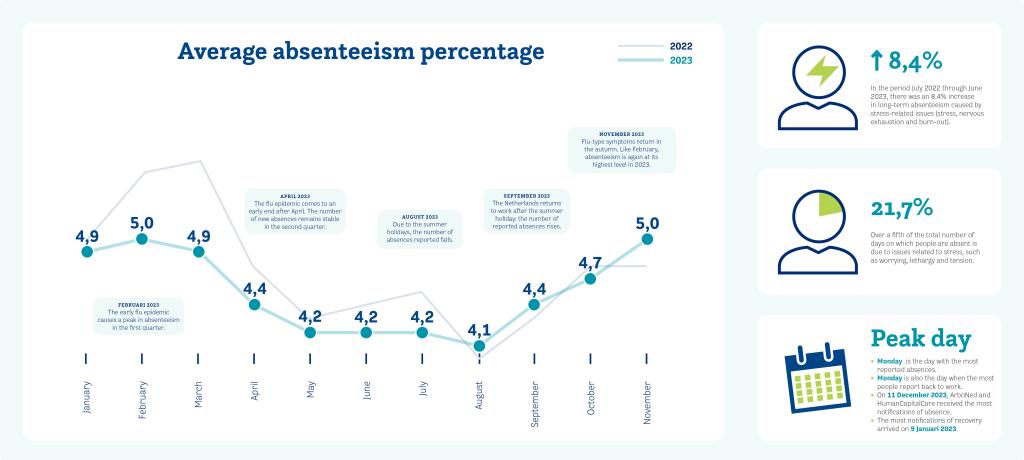Annual sickness absence rate has dropped for the first time since 2014

Trying to maintain the decline is important
In 2023, the average sickness absence rate fell to 4.6%. A year earlier, this average was 4.7%. The sickness absence rate is highest in healthcare and industry, averaging 6.3% and 5.5% respectively. It’s the first time since 2014 that the Netherlands has seen a decline in the sickness absence rate. The trend of increasing long-term sickness absence due to psychological symptoms continues. After a number of years in which the corona pandemic had a major impact on sickness absence figures, this is the right time to start shifting the focus again to preventing employees from dropping out. “In 2023, the usual seasonal trends in sickness absence rates returned. We seem to be putting the strong rise of recent years behind us,” Jurriaan Penders explains, occupational physician and director of medical affairs at HumanCapitalCare. “With the right deployment of resources, we can try to maintain that decline. By being alert to stress-related symptoms, long-term sickness absence can be prevented or shortened.”
No Blue Monday effect
In December, the number of new cases of people calling in sick fell, partly driven by the Christmas holidays. For every 1,000 employees, occupational health and safety service providers received 69 new sickness notifications. In November this figure was still 83. After the Christmas holidays, ArboNed and HumanCapitalCare can see that sickness absence rates are rising again. However, there was no Blue Monday effect around the third Monday in January. Penders: “Monday is the day of the week on which we receive the most sickness notifications, with the highest number being recorded for 2023 on Monday 11 December. However, in the overview of Mondays generating most sickness notifications for last year, the so-called Blue Monday ranks at a modest position of 22.” Monday is a busy day, because it includes calls from people who fell ill during the weekend and still can’t work come Monday.
2024: focus on preventing sickness absence due to psychological symptoms
The prevention of sickness absence due to psychological symptoms will remain an important point of attention for 2024. More than one in every five days of sickness absence is due to stress-related symptoms. “Worrying, lack of energy and anxiety affect your work performance. The cause of this is not always work-related, or at least not entirely,” Penders continues. “Both employers and employees have a role to play in this.”
For employers, the focus is on offering a working environment in which employees can work healthily and safely: physically and mentally. A Hazard Identification and Risk Assessment and Preventive Medical Screening provide insight into this. It’s important for employees to seek help in a timely manner, such as a preventive consultation with the occupational physician. Events in personal life, such as a death or informal care, can also temporarily impact work. Penders: “Psychological symptoms are causing more and more people to drop out for longer periods of time. It’s important to continue to focus on prevention here. This requires employers and employees to continue the dialogue and take timely action where possible.